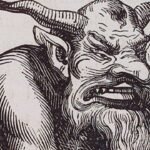Robberies. They’re a messy business. We’ve all heard the gruesome tabloid stories of tweakers with cheap handguns shooting up a liquor store for twenty bucks and a fistful of change. Or maybe the knock-out mugger, arrested after a string of robberies and assaults,
Going to jail for half a decade for money a white collar criminal triples in an hour. These things happen so often in the US that they barely even make the news anymore, and often end up ruining the lives of both the victim and the perpetrator.
But let’s see how a Colombian pro does it without even needing to carry a weapon. A pro like Demencia Black, the street name of a Bogota drug dealer interviewed by Vice in 2012. Demencia doesn’t need to carry a gun or a knife, because he’s packing something even more deadly:
A fistful of Devil’s Breath, a chemical compound dubbed the World’s Scariest Drug by many. And today, you’re going to find out why it’s earned such a terrifying reputation. Let’s say Demencia wants to rob a man for all he’s worth. He’ll spot his target – perhaps a
Businessman boozing at a local night club without a care in the world. The kind of guy with a Swiss watch and a Platinum American Express Card, both of which he loves to flaunt. When nobody is looking, Demencia will stroll towards his target with a smile,
Wearing a casual t-shirt and shorts – hardly the most intimidating outfit for a hardened criminal. But you don’t need to look scary when you have the Devil’s Breath on your side. It’s a fine, white powder, similar to cocaine in appearance. But its effects are an order of magnitude more potent.
Demencia taps his mark on the shoulder, and when the yuppie turns to look at him, Demencia raises his hand – a scoop of Devil’s Breath nestled in his palm – and blows it into his victim’s face. By this point, it’s already over.
In Demencia’s own words, from the aforementioned Vice documentary, “With just that flash the person is totally drugged. You wait a minute and when you see it kick in, then you know that you own that person. You can guide them wherever you want. It’s like they’re a child.”
And for Demencia, this robbery truly is like taking candy from a baby. He tells the drugged businessman to get up and follow him, and the businessman does exactly as he is told without a single complaint. The two of them take an evening stroll to a local ATM, and the
Businessman happily empties his entire bank account for Demencia. After all, people high on the Devil’s Breath aren’t exactly famous for saying “No.” By the time the transaction is over, Demencia has made the kind of score your average American stick-up man can only dream of. And he did it without even carrying a weapon.
A lot of stories about the Devil’s Breath – also known by its scientific names Scopolamine and Hyoscine – play out exactly like this. Whether they’re true or scary urban legends, they often follow the template of a manipulative criminal using the drug to make someone do something
They wouldn’t normally consent to. Because the drug is synthesized from a number of plants, including a type of nightshade common in the upper region of South America, it’s become a favorite among shady characters in the Colombian underworld.
One famous and often repeated example is a man meeting a beautiful woman in a club one evening, and deciding to take her home to his Bogota apartment. However, when he woke up the next morning, he found that the woman was gone and his apartment was totally empty.
Furious, he went downstairs to ask the doorman what had happened. The doorman told him that a van had pulled up in front of the building in the middle of the night, and he and the woman had loaded all of his possessions into the van. He asked the doorman why he didn’t say something,
And the doorman said that he had. The man had just said it was fine, and he knew what he was doing. He would later find that the Devil’s Breath had been slipped into his drink back at the bar, and he’d entered a state so suggestible that he was willing to be
An accomplice in the wholesale burglary of his own apartment. And sadly, robbery is not the full extent of the drug’s use in a criminal context. There have been a disturbingly large number of reports of the Devil’s Breath being used to facilitate forced consent in sexual assaults,
In place of the perennial drug rohypnol, commonly known as “roofies.” Some incredibly sensational reports have even claimed that scopolamine is being used to incapacitate victims for organ harvesting operations. Though to be honest, that last one is most likely about as true as the hook handed man on lover’s lane,
Or the killer hiding in the back seat. The same goes for stories of criminals somehow soaking the drug into business cards and passing them to unwilling victims. As scary as the thought would be – or just the
Thought of having to talk to any stranger for long enough to get their business card – it’s unlikely that there’s any truth to it. There just isn’t much of a pharmacological basis for dangerous quantities of the compound being soaked into the skin through those
Means. But of course, the truth has never gotten in the way of a good horror story. It’s a global tradition to move between eras of drug hysteria every few years, with one fashionable drug at a time typically being labeled the “world’s scariest drug.”
Typically, these drugs are connected to a huge number of horror stories, and given supposed effects that sound like something out of a scary movie. In the 1980s and 1990s, people across the US were terrified that PCP or “Angel Dust” was turning
Drug addicts into unstoppable, superpowered killing machines. A few decades later, after the high profile cannibalistic attack of Rudy Eugene – the so-called “Miami Zombie” – on Ronald Poppo, people were calling Bath Salts the “Zombie Drug.” Despite the fact Eugene was never actually shown to have the drug in his system during the incident.
A wide variety of other drugs have been given this same treatment, from Flakka to Krokodil, and the Devil’s Breath is no exception. However, even if some of the tales of Devil’s Breath terror are exaggerated, or the product of tall tales told by drug dealers getting high off their own supply,
Scopolamine is still a genuinely dangerous drug when abused. In 2015, the US’s Overseas Security Advisory Council gave an unofficial estimate that there are 50,000 scopolamine related incidents in South America every year. Naturally, this has put the fear into potential vacationers considering a Colombian getaway – and likely
Caused a few sleepless nights for members of the Bogota tourist board as a result. Scopolamine can have incredibly toxic effects on the body in high enough doses. Many scientists believe that scopolamine depresses the central nervous system, and can lead to a bevy
Of side effects from hallucinations, to severe drowsiness, to dry mouth, cardiac arrhythmia, and amnesia. If you overdose on this stuff and can’t find treatment in time, it’s extremely likely you won’t live to see tomorrow. And when the elderly are given the drug, it massively increases the
Risk of dementia. So even if it doesn’t turn you into a zombie on the spot, the drug can rob you of your mind and cognitive faculties in even more terrifying ways in the long run. You’d much rather deal with Demencia Black, the Colombian drug dealer,
Than the kind of degenerative dementia that turns your life into a living hell over time. However, there is another side to scopolamine that will probably surprise you. Namely, the fact that it has a wide variety of medicinal uses, even today.
Despite mainly coming into fashion as the “scary South American mind control drug” in the last two decades, scopolamine actually has a long and storied history. Early, unrefined forms of scopolamine and Hyoscine have been in use by various cultures for thousands of years. For
Example, the Aboriginal people of Australia – the oldest continuous culture on earth today – have long used similar chemicals from the soft corkwood tree in Bush Medicine. And because of the powerful psychoactive properties of Hyoscine, it has also been used for spiritual purposes across
The globe for thousands of years, inducing states of ritualistic religious hallucination in users. It entered popular Western medical use in the late 1800s, pioneered first by German scientist Albert Ladenburg and later suggested as a medical anesthetic by surgeon Dr. Schneiderlin.
Because of its wide array of effects, the drug was tried out for various purposes throughout the 19th and 20th Centuries. It came into use as a popular anesthetic for childbirth, an antidote to gastrointestinal spasms, and an effective treatment for postoperative nausea
And vomiting. That last one is actually still one of its most common uses today. Scopolamine and similar chemical compounds have been used to stave off nausea for over a century now. From tribal chiefs to the Allies in World War II storming the beaches of Normandy,
These chemicals have proven to be the most effective in staving off seasickness. But it isn’t just the sea that a small dose of scopolamine can make a world of difference in. Most scientists agree that scopolamine is the gold standard when it comes to preventing all
Kinds of motion sickness, and wearing a small, prescription scopolamine patch can make your travels far smoother than they’ve ever been before. But hey, this video is called “The World’s Scariest Drug”, not “The Drug That’ll Stop You Getting Seasick.” Are there any other frightening uses of scopolamine? The answer
To that question is “Absolutely.” It goes without saying that Colombian drug cartels are unsavory people – vicious, ruthless outlaws who’ll do anything to turn a profit. And if that involves pedaling and using drugs like scopolamine, so be it. But imagine if the drug’s scary, mind-bending
Properties were used by a violent gang in full cooperation with its country’s government? This exact situation played out during the mid-to-late 20th Century in the Czech Republic, thanks to an extremely frightening group called State Security, colloquially referred to as the Czech Secret Police. Much like the East-German Stasi, this group was a ruthless,
Repressive arm of the Soviet puppet-state. They would spy, intimidate, torture, and murder to keep their masters in power. And like a lot of thugs working for repressive government regimes, a big part of their job was forcing confessions out of perceived enemies of the state.
And like a cheesy Bond villain, you better believe that these guys had ways of making you talk. Of course, while State Security were more than happy to grab the rubber batons and bolt cutters for some good, old-fashioned torture, they also liked to mix it up a little. In the early 1900s,
Hyoscine had often been used as a kind of truth serum, but was soon discontinued due to some of the unpleasant side effects we’ve already discussed. But State Security weren’t all that into human rights for their prisoners, so they had no problems with using
A little of the Devil’s Breath on their political prisoners to make them more open to suggestion. It’s extremely likely that the answers produced by this method of questioning were unreliable to incoherent, but again, it’s not like they really cared either way. As long as they got somebody, they were happy.
And that is the story of the Devil’s Breath, a semi-legendary drug favored by eccentric Colombian robbers, sufferers of motion sickness, and shadowy agents of the Czech secret police. Is it the scariest drug in the world? We’ll leave that up for you to decide,
Given that much of its most terrifying stories exist somewhere in the murky space between fact and fiction. But either way, if Demencia Black is walking towards us with a handful of powder, we’ll definitely be making a swift exit before he gets too close.
Now check out “Cocaine vs Heroin – Which Drug Is More Dangerous (Drug Addiction)?” and “How Did He Become the King of Cocaine – Pablo Escobar” for more facts about some gnarly narcotics.
#Devils #Breath #Worlds #Scariest #Drug







No comment yet, add your voice below!